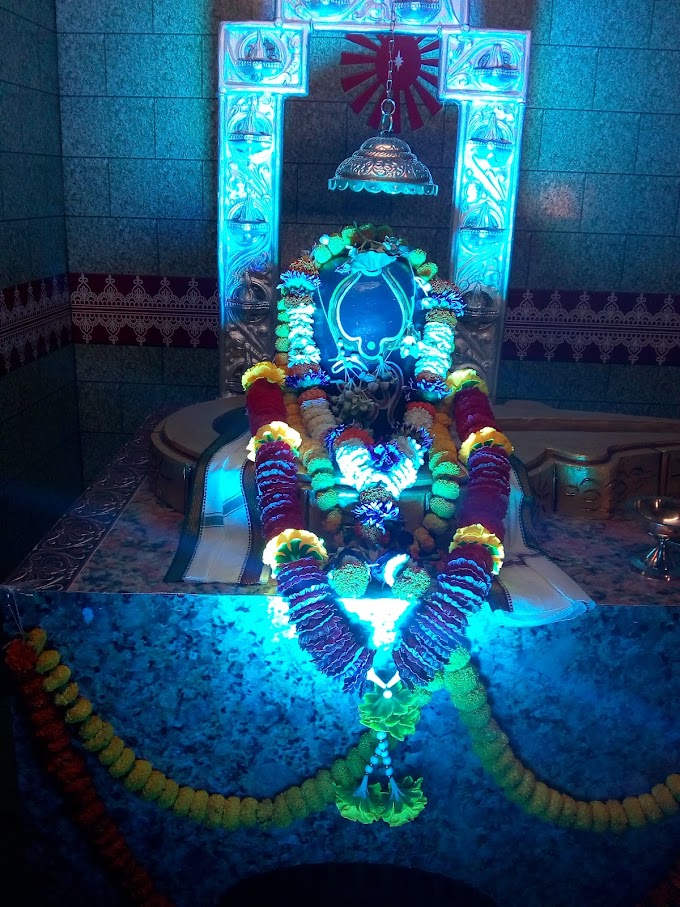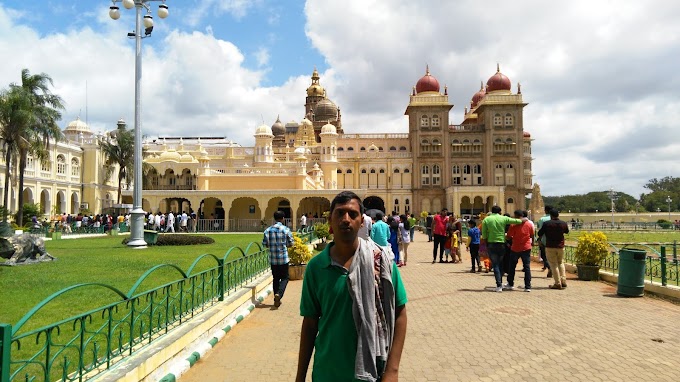“Buddham Saranam Gacchami
Dhammam Saranam Gacchami
Saranam Saramam Gacchami”
The concept of non-violation was generated from Buddhism which makes the Buddhism popular. Maximun does not know about Buddhism for which it is called the separate religion but actually this is a part of Hinduism. As per the Hindu Mythology, Lord Buddha is 9th Avatar of lord Vishnu. Therefore it is not the correct to say that it is non other then a part of Hinduism. The culture of Buddhism and the relationship with Orissa (Odisha) is since prior to Kalinga War. Where the Buddhist monk resided during ancient period, the Buddhism grow up and develop on those places.
Dhauli Hill: The shanti stupa (the Peace Pagda)
there is a relationship between Dhauli Hill and Buddhim since Kalinga War. the History is the witness for that. The monk were resided on this hill top. There are seven Peace Pagda in India and the Dhauli is one of them. on this spot the King Ashoka leaved the violence way and adopted the peace way. This place is dedicated in the name of grate King and called this place Shanti Stupa (the peace pagda)
This Dhauli Shanti Stupa was built on the advice and wish of Sri Nityananda Kanungo, who was the Governor in the year 1969. During the said period Orissa and Bihar was comming
Ratnagiri
Ratnagiri was discovered in 1905. Excavations carried out between 1958 to 1961 revealed a massive stupa, two monasteries, shrines, numerous votive stupas (the excavations turned up as many as seven hundred of them!) a large number of terracotta and stone sculptures, architectural fragments, and plentiful Buddhist antiquities including bronze, copper and brass objects (some with images of Buddha). At present this site is for World Heritage Sites of India.
According to historians, Ratnagiri, founded in sixth century,
along with Udaygiri was a seat of Tantric Buddhism. This centre increased until
12th century. Excavations have revealed of sprawling monasteries, rows of
votive stupas, shrines and richly sculpted doorways and statues. The man
monastery complex contains a large statue of Buddha in the Bhumisparsha mudra. The
court serves as an open-air gallery where Buddha heads and other statues are on
display. It is the only Buddhist monastery in India with a rounded roof and the
monks from here went to teach at Nalanda.
Kuruma
Kuruma, a small village in Puri, is located at a distance of 8
kilometers to the south-east of the sun temple of Konark. Kuruma is
alternatively spelled as Kurum. The place is famous for the ancient Buddhist
site. This site was built between the 9th-10th centuries AD. The place was
first located by Shri Barajabandhu Das who was a school teacher between the period
of 1971 and 1975 and an excavation project was carried out at Kuruma by Odisha
State Archaeological department. Before this time period, a stone slab was
found here that contained an idol of Lord Buddha in Bhumisparsha Mudra. Apart
from this, a couple of more statues were recovered near the pond. The finding
of these statues led to the excavation period.
The hill houses a series of rockcut Buddhist stupas and few
Buddhist shrines old back from early medieval that make it one of the top
tourist attractions of the district. The excavation carried out here uncovers
two panels of rock-cut caves and Dhyani Buddhas. The first panel dates back
from 1st-4th centuries that consists of the series of 34 Stupas. Of these, the
center one in the series is the largest stupa flanked by Vidyadharas that tells
the specimen of the stunning craftsmanship. However, there is one more feature
of the series that include a floral tribute to Stupas. Coming on to the second
panel, which traces its history from the 8th-10th centuries, it includes
stupas, Buddhas in Dhyani mudras, goddess Tara.
Boudh
Boudh Dambarugada is a mountain at a distance of 20 km from
Boudh town closely associated with the development of Vajrayana, the tantric
wing of Buddhism. Many historians give different views regarding the origin and
development of Vajrayana. Many views that it was originated at the time of Lord
Buddha. According to another faction it was developed in the 8th century AD or
during the period of Acharya Indrabhuti (the king of Sambal). The name “Boudh” itself
indicates the close association with Lord Buddha and Buddhist culture.
Dambarugada once upon a time was remained unclear of tantric Buddhism where a
number of Buddhist philosophers stayed for a long period to complete their
spiritual Sadhanas and composed hundreds of valuable tantric philosophical
books.
Pushpagiri
Pushpagiri was built in 3rd century, Pushpagiri ranks as one of
the important institutions of higher learning in ancient India that makes it a
popular heritage site in the country. Xuanzang(Hiuen Tsang) a renowned Chinese
traveler, visited Pushpagiri in 639 along with Vikramshila, Takshashila and
Nalanda. That was the time when he named this place as Pushpagiri Vihara. The
Buddhist center of Pushpagiri also has its description in medieval Tibetan
texts. The complex of Pushpagiri sprawls over three hilltops(Lalitgiri,
Ratnagiri and Udayagiri) that include various Stupas, Temples, Monasteries and
Sculptures which boasts architecture design from the Gupta Period.
Langudi
Langudi, hill houses a series of rock-cut Buddhist stupas and
few Buddhist shrines dated back from early medieval that make it one of the top
tourist attractions of the district. The excavation carried out here uncovers
two panels of rock-cut caves and Dhyani Buddhas. The first panel dates back
from 1st-4th centuries that consists of the series of 34 Stupas. Coming on to
the second panel, which traces its history from the 8th-10th centuries, it
includes stupas, Buddhas in yoga mudras, goddess.
Tarapur
Tarapur is famous for three Stupas built by King Asoka. The recent Tarapur excavation has exposed these sculptures. Several plain railing pillars and crossbars have also been discovered by the Tarapur excavation. Two merchants of Utkal Tapassu and Bhallika became the first lay disciples of Lord Buddha, as per early Vinaya texts. Eight handfuls of his hairs were what Buddha gave them, getting rice cake and honey in return from them. Later on, the merchants deposited the heirs in a stupa (kesa Stupa) in their native place Asitanjana. The excavations done in Ratnagiri, Lalitgiri and Udayagiri by Archaeological Survey of India revealed the wealthy Odisha Buddhist Heritage related to the early Christian era of 15th-16th century AD.
Udayagiri
Udayagiri, which is know as "Sunrise Hill", is home to
another large Buddhist complex in Odisha. It consists of a brick stupa, two
brick monasteries, a stepped stone well with inscriptions on it, and numerous rock-cut
Buddhist sculptures. The Udayagiri site has been old back to 1st-13th centuries
AD. Although it was discovered in 1870, excavations didn't commence until 1985.
They've been undertaken in two phases across two settlements around 200 meters,
Udayagiri 1 from 1985 to 1989, and Udayagiri 2 from 1997 to 2003.
Another attraction at Udayagiri is a gallery of Buddhist
rock-cut images, overlooking the Birupa river. There are five images consisting
of a standing life-size Boddhisattva, a standing Buddha, a goddess seated over
a stupa, one more standing Boddhisattva, and a seated Bodhisattva. The
Udayagiri site promises additional treasures, as there's still more to
excavate. It's open daily from 9 a.m. to 5 p.m. for public.
Ratnagiri
Ratnagiri, which is called as "Hill of Jewels", has the most extensive Buddhist ruins in Odisha and is of great importance as a Buddhist site both for its magnificent sculptures as well as a center for Buddhist teachings. Opce open a time Ratnagiti was a part of Nalanda University at the time of the renowned one at Nalanda University.Lalitgiri
This Buddhist heritage site in Odisha dates back to 1st century
AD. Lalitgiri is an important part of the Diamond Triangle of Odisha which
includes three major ancient Buddhist sites; Ratnagiri and Udayagiri being the
other two. In 1937, the central government gave this place the status of a
protected monument. The major excavation was carried out by Bhubaneswar Circle
of the Archaeological Survey of India between 1985 and 1991 to find the
Pushpagiri. Pushpagiri was mentioned in the writings of the Chinese traveler
Xuanzang. It was this excavation that officially declared Lalitgiri an ancient
Buddhist site in Odisha. Ratnagiri Ratnagiri in Jajpur district of Odisha is
often referred to as the Hill of Jewels. This site is located on an isolated hillock
of Asia Range between Birupa and Brahmani rivers.
. Everyone should go those place which is wonderful natural scenario for the nature lover. i have visited all the place in my college life.















